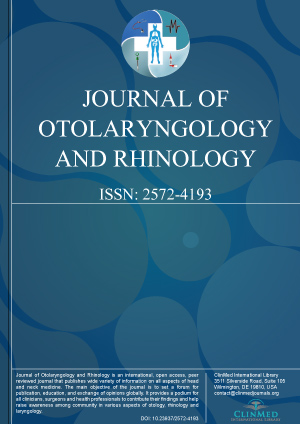Open Access DOI:10.23937/2572-4193.1510044
Interesting Pustules on Pinna
Saliha KARATAY and Berrire KURT
Article Type: Clinical Image | First Published: June 16, 2018
A 56-year-old female patient with osteoarthritis of the knee is presented pustules in her ear corresponding to knee and gastrointestinal auricular points. When she came to our clinic, her primary complaint was knee and hip pain. She had a history of generalized osteoarthritis for eight years. She had tried paracetamol, NSAIDs and hyaluronic acid injections as well physical therapy. Her pain was assessed at 8 by visual analog scale (VAS). We decided to treat her with acupuncture....
Open Access DOI:10.23937/2572-4193.1510043
Middle Ear Pressure Changes Over Time in Children with Down Syndrome
Scott Mitchell, Matthew JV Holmes and Nicholas Turner
Article Type: Research Article | First Published: June 08, 2018
Down syndrome is one of the most common genetic conditions affecting approximately 1 in every 1000 live births. There are a multitude of potential clinical manifestations associated with this condition including dysmorphic features, organic disorders such as congenital cardiac defects, gastrointestinal defects, ocular abnormalities, celiac disease and endocrine disorders along with haemato-oncological, immunological and disorders affecting the ears, nose and throat....
Open Access DOI:10.23937/2572-4193.1510042
Omalizumab: Pharmacological Properties, Primary Therapeutic Effect Mechanisms and Adverse Effects
Oner Ozdemir
Article Type: Review Article | First Published: June 07, 2018
Since it was approved in 2003 by the FDA for the therapy of adult and adolescent moderate-severe persistent uncontrolled allergic asthma, the studies on asthma patients have demonstrated that omalizumab has an encouraging safety report, regardless of the allergic sensitization type. Omalizumab was later tried in the therapy of other Th2-type allergic disorders e.g. allergic asthma. Omalizumab hinders IgE effector functions by preventing IgE joining to high-affinity IgE receptors (FcεRI) on effe...
Open Access DOI:10.23937/2572-4193.1510041
Management of Curved Foreign Bodies in Otorhinolaryngology Practice
Ozan Gokdogan, Hacer Baran, TolgahanCatli and Recep Karamert
Article Type: Case Report | First Published: May 30, 2018
Penetrating injuries usually affects non-dressed parts of body. Most of them treated by patient itself without any intervention. But some of them must be examined and treated by a specialist such as major injuries, minor injuries affecting the important structures and curved foreign bodies. Curved injuries can be made by a curved wire or fishhooks. Fishhooks take an important part of this injuries because of mechanism used in distal part of fishhooks....
Open Access DOI:10.23937/2572-4193.1510040
Recurrent Respiratory Papillomatosis: Review and Treatment Update
Alfonso Reyes Escobedo, Karla M Santos Santillana and Jose Luis Trevino Gonzalez
Article Type: Review Article | First Published: May 28, 2018
Recurrent respiratory papillomatosis (RRP) is a benign tumor of the respiratory tract caused by the human papillomavirus (HPV). It is considered as a manageable rather than a curable disease because of its high recurrence rates and its unpredictable clinical course. The unique molecular characteristics of the virus, induces cellular proliferation causing airway obstruction....
Open Access DOI:10.23937/2572-4193.1510039
Chondroblastoma of Ventral Skull Base: First Report of a Case
Ahmad Elkhatib, Paul Wakely Jr, Luciano M Prevedello, Ralph Abi Hachem, Andre Beer-Furlan, Daniel M Prevedello and Ricardo Carrau
Article Type: Case Report | First Published: May 25, 2018
Report of the first case of chondroblastoma involving the sinonasal cavity and ventral skull base, offering a description of the puzzling diagnostic process followed by its management. We describe the main radiologic and histologic characteristics of chondroblastoma and compare them to those of frequently mistaken differential diagnoses....
Open Access DOI:10.23937/2572-4193.1510038
Buccal Space Giant Cell Angiofibroma: Case Report and Review of Head and Neck Occurrences
Moustafa W Mourad, Sami P Moubayed and Edward Shin
Article Type: Case Report | First Published: May 24, 2018
Giant cell angiofibroma (GCA) was first described in 1995, as a previously unrecognized soft tissue tumor of the orbit. Since that time, rare extraorbital head and neck manifestations of GCA have been documented. To the best of our knowledge, we present the fourth documented case of GCA of the buccal cavity, constituting the largest dominant site of occurrence in the extraorbital head and neck....
Open Access DOI:10.23937/2572-4193.1510037
NK/T-Cell Lymphoma Presenting as a Post-Operative Nasal Septal Perforation: A Diagnostic Challenge
Mahir Khuri, Riad Khniefes, Noam Yehudai and Rabia Shihada
Article Type: Case Report | First Published: May 17, 2018
Lymphoma of the nasal cavity represent only 0.2-2% of head and neck lymphomas. Treatment is medical with an overall low 5-years survival between 40% and 59%. There are high rates of relapse as well as radiotherapy and chemotherapy resistance. We present a 44-year-old male, who was admitted to our department due to chronic sinonasal infection, complicated by a large septal perforation and nasal tissue necrosis, which developed over several months following an elective septoplasty surgery performe...
Open Access DOI:10.23937/2572-4193.1510036
Rhinotillexomania in a Cystic Fibrosis Patient Resulting in Septal Perforation
Mark Gelpi, Emily N Ahadizadeh, Brian D'Anzaa and Kenneth Rodriguez
Article Type: Case Report | First Published: April 30, 2018
Cystic fibrosis (CF) is a multisystem disease that can have significant sinonasal manifestations. Viscous secretions are one of several factors in CF that result in chronic sinonasal pathology, such as sinusitis, polyposis, congestion, and obstructive crusting. Persistent discomfort and nasal manifestations of this disease significantly affect quality of life....
Open Access DOI:10.23937/2572-4193.1510034
Cricoid Pressure during Rapid Sequence Induction - Time to Let Go and Grab the Ultrasound?
RA Fearnley, S Badiger, CA Oti and I Ahmad
Article Type: Research Article | First Published: January 20, 2018
Accurate localisation of the cricoid cartilage is a key step in the successful application of cricoid pressure during rapid sequence induction. Poorly localised pressure is unlikely to confer any protective benefit to our patients and may have deleterious effects on laryngoscopy. We postulated that the use of ultrasound would greatly improve the accuracy of cricoid cartilage localisation prior to the application of cricoid pressure....

